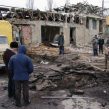
Recent Russian Survey Finds Terrorism Threat Highest in Dagestan
Publication: Eurasia Daily Monitor Volume: 9 Issue: 206
By:

The Petersburg Politics Foundation along with the Regnum news agency recently produced a joint assessment of socio-political stability in Russia’s regions, using a ten-point scale, and identified three North Caucasian republics—Chechnya, Ingushetia and Dagestan—as being among the worst (https://slon.ru/russia/top_15_neozhidannykh_sobytiy_v_rossiyskikh_regionakh-848640). According to the president of the Center for Strategic Research, Mikhail Dmitriev, the fact that Dagestan is in last place in the ranking shows that experts assess the terrorism threat in this republic as the highest in the country (www.19rus.info/news/89775.html).
This ranking would be counted as an accurate estimate of the situation in the North Caucasus, were it not for the Russian Interior Ministry, which is trying to portray the current situation in the region as almost an improvement over previous years. Residents of the North Caucasus can hardly believe the Interior Ministry’s optimistic reports. According to the ministry’s information, in the period from January to September 2012, the police killed 42 rebels and arrested 15 others who were on the federal wanted list. Three hundred terrorism-related crimes were committed in this period, including 191 gun attacks and 96 bombings. The total number of such events is 6.5 percent lower than in the same period of the previous year. In Chechnya, terrorism-related crimes declined by one-third, in Kabardino-Balkaria almost by one-quarter and in Dagestan by 10.3 percent (www.interfax-russia.ru/South/news.asp?id=357798&sec=1671).
Last month, the National Anti-Terrorist Committee (NAK) provided more detailed information on the loss of human lives. “Since the start of 2012, the Russian law enforcement agencies and security services eliminated 380 rebel bases, arrested about 500 members of the illegal armed groups, and confiscated over a ton of explosives and over 120,000 pieces of ammunition” (www.infox.ru/authority/defence/2012/10/18/S_nachala_goda_na_Sy_print.phtml). However, speaking at a meeting with counter-terrorism agencies on October 16, President Vladimir Putin announced very different figures. According to Putin, 479 rebels were detained and 313 rebels were killed, including 43 leaders, in the same time period. It is not hard to guess that despite the Russian leadership’s constant calls on the security services to coordinate their actions when fighting the insurgents in the North Caucasus, much progress is left to be made in this area.
The Russian authorities’ anxiety about the situation in Dagestan was apparent in Ramzan Kadyrov’s critical remarks about the external appearance of police checkpoints on Chechen territory. Kadyrov said that there were 28 police checkpoints in Chechnya that were not under the Chechen authorities’ control and that 17 of them would be relocated to Dagestan. “Thus only 11 large checkpoints will remain in the republic, some of which are situated on the outer administrative borders of Chechnya, some in Grozny and the mountainous areas,” Kadyrov said (www.yuga.ru/news/277731/). These checkpoints are evidently manned by personnel from Russian regions located outside the North Caucasus.
Thus it appears Moscow is pursuing the same plan for Dagestan that it has pursued in Chechnya since 1999. It should be noted, however, that actual militants were not usually stopped at these checkpoints; rather, the police would stop individuals to extract money from them, or randomly detain people who would be then tossed about from one detention center to another before their relatives could locate them (https://www.kavkaz-uzel.ru/articles/215189/). So, while the authorities claim that rebel activity is declining in the North Caucasus in general and in Dagestan in particular, they have increased the presence of non-Dagestani police in the republic. The move is apparently a signal of distrust of the local police and an attempt to control the situation in the area, bypassing local police.
Meanwhile, insurgent attacks in Dagestan continue. On the evening of November 4, a police officer in the city of Buinaksk was injured when an improvised explosive device (IED) detonated under his car. The IED was affixed to the bottom of the vehicle (www.kavkaz-uzel.ru/articles/215178/).
On November 5, an unknown assailant shot the chief of the forensic service in Makhachkala’s Kirovsky district, Valery Aidaev, in the head. Aidaev died on the way to the hospital (www.regnum.ru/news/kavkaz/dagestan/1589783.html). Investigators are convinced that he was killed for his professional activities.
At approximately the same time, on November 4 and 5, authorities announced massive arrests in the city of Kizlyar and Kizlyar district in northern Dagestan. In a joint operation, the Federal Security Service (FSB) and police arrested eight armed suspected rebels (www.riadagestan.ru/news/2012/11/5/145530). This great success for the security services was probably made possible by a mole planted inside the insurgency. All those arrested had weapons on them, including grenade launchers and Kalashnikovs.
The situation in Dagestan remains tense and there are no signs of improvement in the republic. The republican authorities, who are Kremlin puppets, perceive their obligations solely as providing support for the federal authorities. So the republican government devises superficial festivals, forums and competitions meant to show how stable and prosperous Dagestan is. Plans to build a ski resort right in the middle of the Muslim-majority republic are also part of the same show, as if there were no more pressing issues in the republic, where the Salafist movement grows stronger every day. Therefore, one should not expect any positive news from the region as the jihadist-inspired armed opposition ratchets up its activities.




